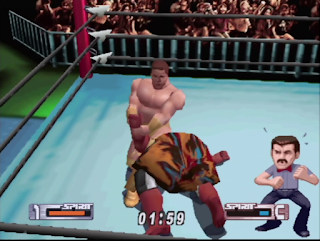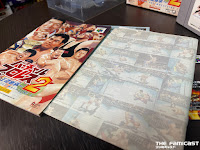Like many of you, I’m a firm believer that wrestling games just don’t get any better than what was on offer from AKI on the Nintendo 64. While many games have tried over the years to capture the magic, most fall short. For the series’ swan song in Japan, AKI put together what a lot of people believe is the best wrestling game ever made in Virtual Pro Wrestling 2: Ōdō Keishō (Royal Road Succession). Is this game really the GOAT and is it worth tracking down these days to play? We’re here to talk about all of this and more in this retro review.
Release
Virtual Pro Wrestling 2: Ōdō Keishō, often translated as Royal Road Succession, was originally released in Japan on January 28, 2000. This was just a few months after AKI’s WWF Wrestlemania 2000 hit the Nintendo 64 in the West (it would later come to Japan in September 2000). The game was relatively well received in Famitsu, earning a respectable score of 30 out of 40. This was the second and final exclusive Nintendo 64 wrestling game from AKI behind Virtual Pro Wrestling 64.
Gameplay
If you’re familiar with AKI wrestling games, you will be right at home with VPW2. The grapple system is back and still feels great. If you’re unfamiliar, the main takeaways are that control pad is used for movement, the joystick for taunts, B for strikes, A for grapples. Grapples offer a bit more nuance, too. A short tap performs a weak grapple, while a long press performs a strong grapple. While in grapples, moves can be done with the press of A or B and a direction (up, down, left or right). Each wrestlers has a number of moves at their disposal, and just like other games in the series, things here feel great. It’s one of those kind of games that is easy to pick up and play but difficult to master.
The roster is full of brawlers from a number of different Japanese promotions. Unlike Virtual Pro Wrestling 64, which featured quite a few wrestlers from the WCW roster, VPW2 does not offer anyone from American promotions. Things here are based on athletes that were wrestling in Japan at the time, some fighters and a handful of legends. Some of the Japanese wrestlers include Giant Baba, The Great Muta (Keiji Mutoh), Tiger Mask, and others. Some familiar former American based wrestlers are also on the roster, including Vader, Kamala, Scott Norton and some legends like Andre the Giant, Bruiser Brody, Ultimo Dragon and many others. Simply put, there are a lot of great wrestlers on the roster. If you get a new copy of the game, you might notice that some of the names were altered a bit to avoid copyright issues, but these can easily be edited. My copy already had most, if not all of these changed.
In terms of match types, everything here feels pretty familiar. You have singles, tag team, three way matches, battle royal and elimination. Of course, the main thing missing here compared to it’s western counterpart, WM2000, is the cage match. There’s a good reason for that (as I’m sure many Japanese wrestling fans may know) - they just aren’t that common in Japanese wrestling. While it would have been cool to have them, it’s at least being mostly true to its source in that respect.
Perhaps the biggest change made with the game comes with the inclusion of MMA style fights. These differ quite a bit from the standard wrestling matches. While the button layout for controls remain the same at large, the A and B buttons do different things depending on your brawler of choice. You won’t be whipping anyone to the ropes or performing any over the top bodyslams. Most of the moves are ground or strike based. Basically, your goal is to make your opponent tap or get knocked out. Additionally, the grapple strikes that were introduced in WCW / NWO Revenge make a return (they are not in WM2000). Mixed matches with wrestlers and fighters are also possible here, too, which can keep things interesting. This unique inclusion really sets this game apart from all of the others in the AKI series of games and almost feels like a completely different game inside of the game. Of course, this style of play might not be to everyone’s liking. I prefer the standard wrestling action myself, however, this definitely gives players something cool that most wrestling games wouldn’t even attempt to include.
One small wrinkle added to the game are multiple referees. While they add an obvious visual difference, each referee differs in the speed that they count. It’s an interesting, but a bit of an unnecessary addition. I prefer to use one of the faster counting referees, but it’s nice that there are options.
Modes
If you just give Virtual Pro Wrestling 2 a quick glance, you might think that it’s just a copy of Wrestlemania 2000 on the surface. While both games do share the same engine, VPW 2 does offer a few things to set it apart from its Western counterpart. In terms of modes, the following are on offer - Exhibition, League, Rally, Edit Mode, Royal Road Succession, Tournament, Ranking and Options. Some of these are pretty self explanatory (and we talked about match types previously), but some of these need a bit of explanation. In League, you can choose up to 12 wrestlers to compete in a round robin style tournament. Basically, the more you win, the more points you accrue through in the League. The wrestler with the most points after all of the matches are finished is the winner.
Tournament differs from Rally in the sense that matches are single elimination. Once the wrestler (or their team) is eliminated, they’re done. Pretty straight forward. Rally will let you create your own wrestling event - you decide the matches, rules, who participates and more. It’s more or less the Pay-Per-View Mode from WM2000.
Royal Road Succession takes players through a year on the pro wrestling circuit in a somewhat similar way to Road to Wrestlemania in WM2000 does. You’ll play through singles, tag matches, tournaments, compete for championship belts, trophies and more. I’m not super familiar with Japanese wrestling (then or now), but it seems to be as faithful to the sport as it can. One noticeable difference between this and WM2000 is the lack of dialogue between wrestlers. Regardless, this mode will likely be the main draw for most people as it is a way to get many of the game’s unloackable characters. I really had a lot of fun playing through this and can see people going back multiple times.
As mentioned previously, a comprehensive Create-a-Wrestler mode is included in this game under “Edit.” Not only that, but as with Revenge and beyond, you are able to edit all of the wrestlers on the roster. There really are a ton of options here, so creating yourself, friends, some weirdo from the inner recesses of your brain or even Western wrestlers is possible. I didn’t go too crazy with this here, but I did spend a few hours creating myself for the game. If you find yourself having trouble wading through the Japanese (you CAN preview pretty much everything, but that takes a bit of time) there are several guides available to assist you. There is also a pretty comprehensive mask editor as well as the ability to create championship belts.
Visuals, Audio & Performance
VPW2 doesn’t bring too much new to the table visually. Wrestlers still clip through each other and the environment from time to time, but the game runs pretty smoothly. Several audio clips are also in the game, including introductions for a handful of wrestlers pre-match. For those that aren’t included, the announcer has a generic call. It’s generally not as flashy as what you would find in the Western based AKI wrestling games, but it seems to be pretty true to Japanese wrestling (as far as I know). The venues here are also varied, providing a handful of stadiums based on real-life venues in Japan.
If you’ve played WWF Wrestlemania 2000, things will sound very familiar in VPW2. The menus and menu music are almost identical with the main difference being Japanese replacing the English. For me, these can be forgiven considering that they were going after a different audience with the games. The carry over might not have been there (WWF/WCW fans in Japan) but this game does stand on its own when it comes to wrestlers and the atmosphere that was built. I really enjoy the full entrances (starting in the locker rooms), the stadium announcers
While I think the presentation here is amazing, my lack of familiarity with Japanese wrestling and wrestlers from the time outside of American promotions don’t make this hit as hard as AKI’s other licensed Western focused games.
Collector’s Corner
I managed to pick up a boxed copy of VPW2 back in 2012 for super cheap - something like ¥800 while visiting some game shops in Tokyo. These days, it’s getting a bit harder to find boxed, even via resellers online here in Japan. The box for my copy is a little bit dingy on the bottom, but is overall pretty clean. It came with all of the inserts and manuals, too. There’s also a registration card for the game, the information card that comes with all Nintendo 64 games in Japan, and a little postcard promoting the release of Wrestlemania 2000 (which at the time had a blanket 2000 release). VPW2 comes with two manuals - one being the general instruction manual and the other being a booklet containing moves for all of the wrestlers included in the game. Although this game may be a little bit expensive, especially if you’re looking for a boxed copy, I think it’s worth tracking down to add to your collection.
Conclusion
Virtual Pro Wrestling 2 takes the best of what the AKI games had and surpassed all previous entires in terms of variety. The MMA style fighting on top of the already solid pro-wrestling gameplay gives gamers more to do. Even with that said, the nostalgia factor might not hit for those that aren’t familiar with the Japanese wrestling scene from the time. Regardless, this begs the question - is VPW2 the best wrestling game ever created? I think it’s close, and objectively, maybe. For me, it just misses the mark, mainly because of my unfamiliarity with the roster (I’d give the nod to Wrestlemania 2000). Still, the game is super fun and should be something that wrestling fans check out. But let’s turn things over to you. Is VPW 2 the best wrestling game ever created? What wrestling game deserves that title? Be sure to sound off in the comments below. We’d love to hear from you.
Also, we have retro review for other Nintendo 64 AKI wrestling games. You can check those out below:




















No comments:
Post a Comment